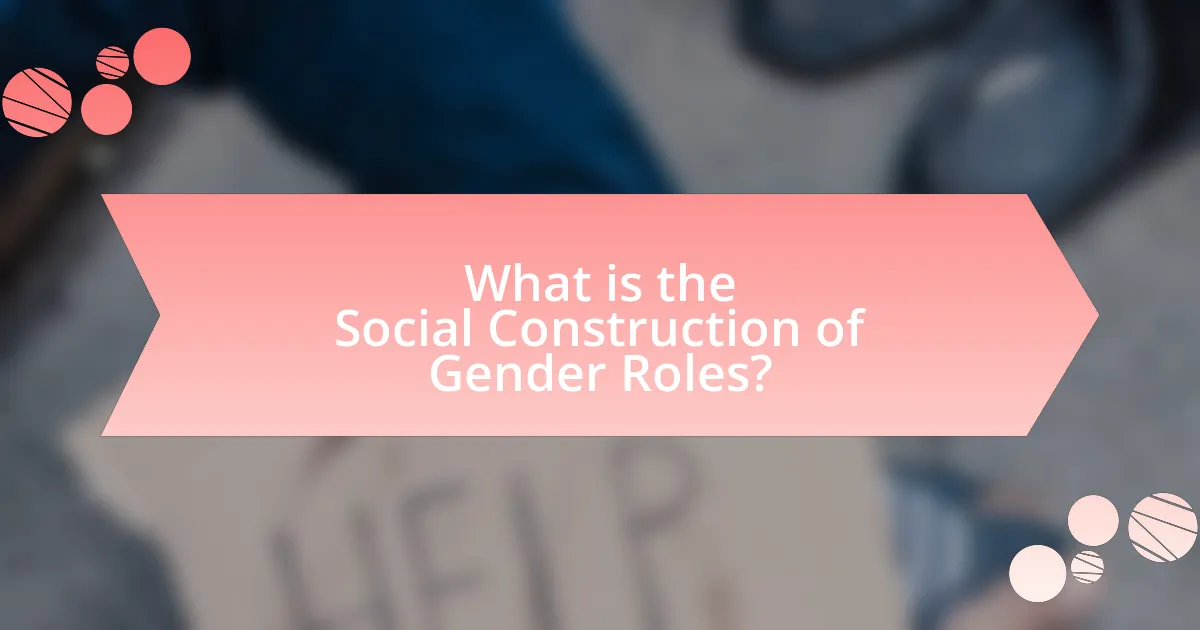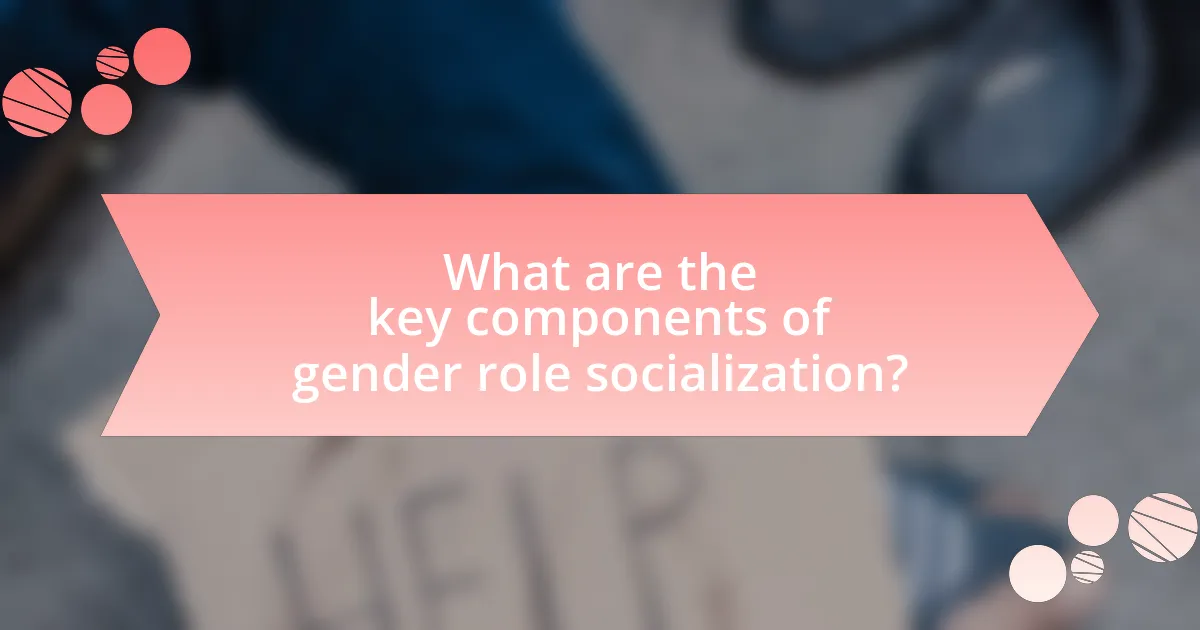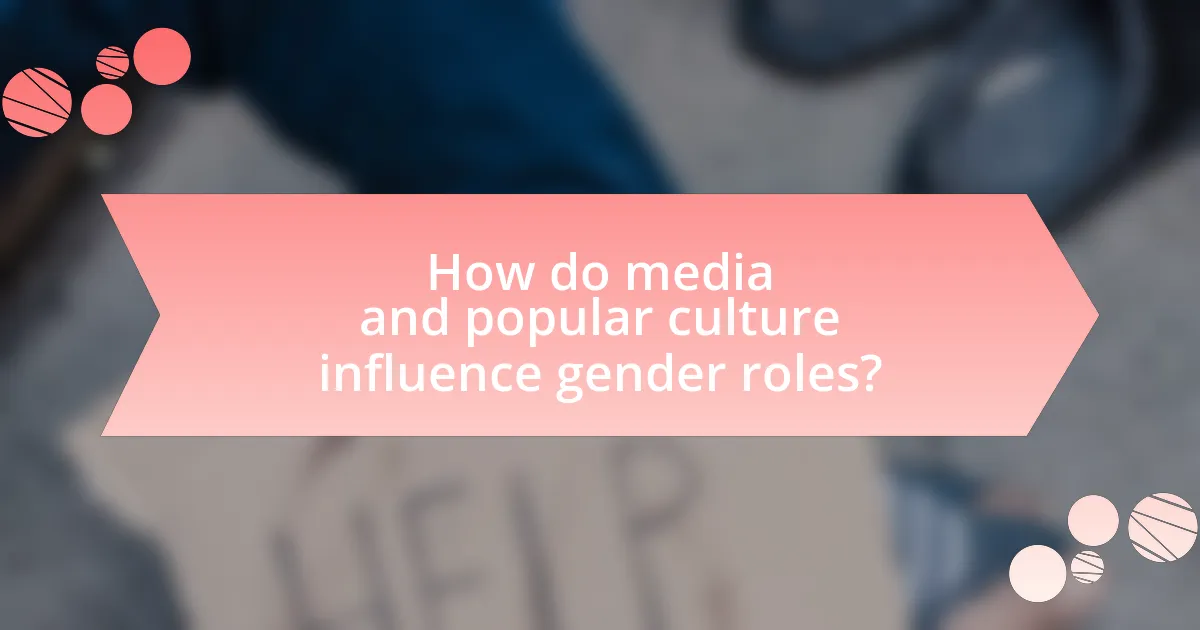The article “Exploring the Social Construction of Gender Roles” examines how societal norms and expectations shape behaviors based on perceived gender, emphasizing that these roles are culturally and historically constructed rather than biologically determined. It discusses the influence of societal norms, historical factors, and cultural differences on gender role development, highlighting the roles of family, education, media, and peer interactions in socializing gender expectations. The article also addresses the implications of gender roles on individual identity and interpersonal relationships, as well as the importance of studying these constructs to promote equity and inclusivity. Additionally, it explores how media representation can challenge traditional gender roles and offers practical steps for redefining gender expectations within communities.

What is the Social Construction of Gender Roles?
The social construction of gender roles refers to the societal norms and expectations that dictate how individuals should behave based on their perceived gender. These roles are not biologically determined but are shaped by cultural, historical, and social contexts. For example, traditional views often assign caregiving and nurturing roles to women while designating leadership and assertiveness to men. Research indicates that these roles can vary significantly across different cultures and time periods, demonstrating that gender roles are learned behaviors rather than innate characteristics. Studies, such as those by Judith Butler in “Gender Trouble,” highlight how these constructs influence personal identity and societal interactions, reinforcing the idea that gender is a performance shaped by societal expectations.
How do societal norms shape our understanding of gender roles?
Societal norms significantly shape our understanding of gender roles by establishing expectations and behaviors deemed appropriate for different genders. These norms are reinforced through cultural practices, media representations, and institutional structures, which collectively influence individual perceptions and societal expectations. For example, traditional norms often dictate that men should be assertive and career-oriented, while women are expected to be nurturing and family-focused. Research by Eagly and Wood (1999) in “The Origins of Sex Differences in Human Behavior: Evolved Dispositions versus Social Roles” highlights how these societal expectations lead to the internalization of specific gender roles, affecting personal identity and social interactions. Thus, societal norms not only define gender roles but also perpetuate them through various socialization processes.
What historical factors have influenced gender role construction?
Historical factors that have influenced gender role construction include economic systems, religious beliefs, and political structures. For instance, during agrarian societies, labor division based on gender was prevalent, with men typically engaging in farming and women in domestic tasks, reinforcing traditional roles. Additionally, religious doctrines, such as those found in Christianity and Islam, have historically prescribed specific roles for men and women, often emphasizing male authority and female submission. Political movements, such as the suffrage movement in the early 20th century, challenged existing gender norms and led to shifts in societal perceptions of gender roles. These factors collectively shaped the expectations and behaviors associated with gender throughout history.
How do cultural differences impact gender roles?
Cultural differences significantly impact gender roles by shaping societal expectations and behaviors associated with masculinity and femininity. For instance, in many Western cultures, gender roles often emphasize individualism and equality, leading to more fluid roles where women participate actively in the workforce and men engage in domestic responsibilities. Conversely, in some traditional societies, rigid gender roles are prevalent, where men are primarily seen as breadwinners and women as caregivers, limiting opportunities for both genders. Research by Geert Hofstede highlights how cultural dimensions, such as masculinity versus femininity, influence these roles; societies with high masculinity scores tend to reinforce traditional gender roles, while those with lower scores promote gender equality. This evidence illustrates that cultural context is crucial in defining and perpetuating gender roles across different societies.
Why is it important to study the social construction of gender roles?
Studying the social construction of gender roles is important because it reveals how societal norms and expectations shape individual identities and behaviors. Understanding these constructions allows for critical examination of power dynamics, inequalities, and the impact of stereotypes on both personal and collective levels. Research indicates that rigid gender roles can lead to negative outcomes, such as mental health issues and limited opportunities, as seen in studies by Eagly and Wood (1999) in “The Origins of Sex Differences in Human Behavior: Evolved Dispositions versus Social Roles,” which highlight how social roles influence behavior and perceptions. By analyzing the social construction of gender roles, individuals and societies can work towards greater equity and inclusivity.
What implications do gender roles have on individual identity?
Gender roles significantly shape individual identity by influencing behaviors, expectations, and self-perception. These roles dictate societal norms regarding masculinity and femininity, which individuals often internalize, affecting their choices and interactions. For instance, research indicates that rigid gender roles can lead to identity conflicts, particularly for those who do not conform to traditional expectations, as seen in studies like “Gender Role Conflict Scale” by O’Neil, which highlights how men may struggle with emotional expression due to societal pressures. This internalization can result in limited personal development and mental health issues, demonstrating the profound impact of gender roles on individual identity formation.
How do gender roles affect interpersonal relationships?
Gender roles significantly influence interpersonal relationships by shaping expectations and behaviors between individuals. These roles dictate how men and women should interact, often leading to stereotypes that can limit emotional expression and communication. For instance, traditional gender roles may encourage men to adopt dominant behaviors while discouraging vulnerability, which can hinder open dialogue in relationships. Research by Eagly and Wood (1999) in “The Origins of Sex Differences in Human Behavior” indicates that these socially constructed roles can lead to power imbalances, affecting relationship dynamics and satisfaction. Consequently, adherence to rigid gender roles can create barriers to intimacy and understanding, ultimately impacting the quality of interpersonal connections.

What are the key components of gender role socialization?
The key components of gender role socialization include family, education, media, and peer influence. Family serves as the primary agent, where parents and siblings model and reinforce gender-specific behaviors and expectations. Education systems further perpetuate gender roles through curriculum choices and teacher interactions, often leading to differentiated treatment based on gender. Media plays a significant role by portraying stereotypical gender roles in television, films, and advertising, which shapes societal perceptions of masculinity and femininity. Peer influence becomes crucial during adolescence, as individuals often conform to group norms regarding gender behavior to gain acceptance. These components collectively contribute to the internalization of societal norms related to gender.
How do family dynamics contribute to gender role development?
Family dynamics significantly influence gender role development by shaping children’s perceptions and expectations of gender behaviors. Parents and siblings model behaviors that children often imitate, reinforcing traditional gender roles. For instance, research indicates that children observe and internalize the division of labor within the household, where mothers may take on caregiving roles while fathers engage in breadwinning activities. This modeling can lead to children adopting similar roles in their future relationships. A study by Liss et al. (2013) published in the Journal of Family Psychology found that parental attitudes towards gender roles directly affect children’s beliefs about gender-appropriate behaviors, demonstrating the critical role of family in socializing gender norms.
What role do parents play in shaping gender expectations?
Parents play a crucial role in shaping gender expectations by modeling behaviors and attitudes that children internalize. Through direct communication, reinforcement of gender-specific behaviors, and the division of household responsibilities, parents establish norms that influence their children’s understanding of gender roles. Research indicates that children observe and imitate their parents, leading to the adoption of gendered behaviors that align with societal expectations. For instance, a study published in the journal “Child Development” found that parental attitudes towards gender significantly affect children’s beliefs about gender roles, demonstrating that children raised in egalitarian households tend to have more flexible views on gender compared to those from traditional households.
How does sibling interaction influence gender identity?
Sibling interaction significantly influences gender identity by providing a context for the negotiation and reinforcement of gender roles. Through play, communication, and modeling behaviors, siblings contribute to each other’s understanding of gender expectations. For instance, research indicates that siblings often engage in role-playing activities that reflect societal norms, which can shape their perceptions of masculinity and femininity. A study by McHale et al. (2003) found that siblings who engage in gender-typed play are more likely to adopt traditional gender roles, demonstrating the impact of sibling dynamics on the development of gender identity.
What impact do educational institutions have on gender roles?
Educational institutions significantly shape gender roles by influencing socialization processes and reinforcing societal norms. Schools serve as primary environments where children learn about gender expectations through curricula, peer interactions, and teacher behaviors. Research indicates that educational settings often perpetuate traditional gender roles, as evidenced by studies showing that teachers may unconsciously favor boys in STEM subjects while encouraging girls in humanities, thereby affecting students’ self-perception and career aspirations. For instance, a study published in the journal “Psychological Science” by Sarah-Jane Leslie and colleagues found that gender stereotypes in educational contexts can lead to decreased interest and performance in subjects perceived as gender-typed. Thus, educational institutions play a crucial role in either challenging or reinforcing existing gender norms.
How do teachers and peers reinforce gender norms?
Teachers and peers reinforce gender norms through socialization practices and behavioral expectations. Teachers often model and promote gender-specific behaviors by encouraging boys to engage in competitive activities and girls to participate in cooperative tasks, thereby perpetuating traditional gender roles. Peers contribute by enforcing conformity to these norms through social interactions, where deviations from expected gender behaviors can lead to social sanctions or exclusion. Research indicates that children as young as three years old begin to internalize these norms, as evidenced by studies showing that children prefer same-gender playmates and activities that align with societal expectations of masculinity and femininity.
What subjects are typically associated with specific genders in schools?
Subjects typically associated with specific genders in schools include mathematics and science for boys, while girls are often linked to humanities and arts. Research indicates that societal stereotypes influence these associations, with boys being encouraged to pursue STEM (Science, Technology, Engineering, and Mathematics) fields, while girls are often steered towards subjects like literature and social studies. A study by the American Association of University Women found that girls are underrepresented in advanced math and science courses, reflecting broader societal expectations and gender norms.

How do media and popular culture influence gender roles?
Media and popular culture significantly influence gender roles by shaping societal perceptions and expectations of masculinity and femininity. Through various forms of content, such as television shows, movies, advertisements, and social media, these platforms often reinforce traditional stereotypes, depicting men as dominant and women as nurturing. For instance, a study by the Geena Davis Institute on Gender in Media found that women are often underrepresented in film and television, with only 31% of speaking characters being female, which perpetuates the notion that men are the primary actors in society. Additionally, popular culture often glorifies hyper-masculine traits and objectifies women, further entrenching these roles in the collective consciousness. This consistent portrayal influences individual behavior and societal norms, leading to the internalization of these gender roles across different demographics.
What messages about gender do films and television convey?
Films and television convey messages about gender that often reinforce traditional stereotypes and roles. For instance, male characters are frequently depicted as dominant, assertive, and emotionally stoic, while female characters are often portrayed as nurturing, passive, and focused on relationships. Research by the Geena Davis Institute on Gender in Media found that women are underrepresented in film and television, comprising only 31% of speaking characters in family films, which perpetuates the notion that men are the primary figures in society. Additionally, the portrayal of women in sexualized roles contributes to the objectification of female characters, further entrenching gender norms. These representations shape societal perceptions of gender roles, influencing audience attitudes and behaviors regarding masculinity and femininity.
How do advertising strategies perpetuate gender stereotypes?
Advertising strategies perpetuate gender stereotypes by consistently portraying men and women in traditional roles that reinforce societal expectations. For instance, advertisements often depict women as caregivers and homemakers, while men are shown as assertive and dominant figures, which aligns with historical gender norms. Research by the Geena Davis Institute on Gender in Media found that only 29% of speaking characters in family films are female, illustrating a significant underrepresentation that reinforces the stereotype of male authority. Additionally, a study published in the Journal of Advertising Research indicated that ads featuring gender-stereotypical roles lead to the internalization of these stereotypes by audiences, further entrenching them in societal perceptions.
What role does social media play in shaping modern gender perceptions?
Social media significantly influences modern gender perceptions by providing a platform for diverse expressions of gender identity and challenging traditional norms. Through user-generated content, individuals can share personal experiences and perspectives that promote awareness and acceptance of various gender identities. For instance, studies show that platforms like Instagram and TikTok have enabled the visibility of non-binary and transgender individuals, fostering a broader understanding of gender beyond the binary framework. Additionally, social media campaigns, such as #MeToo and #TimesUp, have highlighted issues of gender inequality and violence, prompting societal discussions and shifts in attitudes towards gender roles. These dynamics illustrate how social media acts as a catalyst for evolving gender perceptions in contemporary society.
How can media representation challenge traditional gender roles?
Media representation can challenge traditional gender roles by depicting diverse and non-stereotypical portrayals of gender identities and behaviors. For instance, films and television shows that feature strong female leads in roles typically reserved for men, such as action heroes or leaders, disrupt the conventional narrative that associates masculinity with strength and authority. Research by the Geena Davis Institute on Gender in Media indicates that when women are portrayed in varied roles, it not only influences societal perceptions but also encourages young audiences to envision broader possibilities for their own identities. This shift in representation can lead to a re-evaluation of societal norms regarding gender, fostering greater acceptance of diverse gender expressions and roles.
What examples exist of media that promote gender equality?
Media that promotes gender equality includes television shows like “The Good Place,” which features strong female characters in leadership roles, and films such as “Hidden Figures,” which highlights the contributions of women in STEM fields. Additionally, advertising campaigns like Always’ “Like a Girl” challenge stereotypes by empowering young girls. Research indicates that media representation significantly influences societal perceptions of gender roles, as evidenced by studies showing that diverse portrayals can lead to increased acceptance of gender equality.
How can audiences critically engage with gender portrayals in media?
Audiences can critically engage with gender portrayals in media by analyzing the representation of gender roles and questioning the underlying messages conveyed. This engagement involves recognizing stereotypes, assessing the diversity of characters, and evaluating the impact of these portrayals on societal perceptions of gender. Research indicates that media representations can shape public attitudes; for instance, a study by the Geena Davis Institute on Gender in Media found that female characters are often underrepresented and depicted in limited roles, which can reinforce harmful stereotypes. By actively questioning these portrayals and advocating for more nuanced and equitable representations, audiences can contribute to a broader understanding of gender roles and challenge the status quo in media narratives.
What are practical steps to challenge and redefine gender roles?
To challenge and redefine gender roles, individuals and communities can implement several practical steps. First, education plays a crucial role; incorporating gender studies into school curricula can raise awareness about the social construction of gender roles. Research indicates that educational interventions can significantly alter perceptions of gender norms (Smith, 2020, Journal of Gender Studies).
Second, promoting diverse representations in media and literature can help normalize non-traditional gender roles. Studies show that exposure to varied gender portrayals can influence societal attitudes and expectations (Johnson & Lee, 2019, Media Psychology).
Third, engaging in open dialogues about gender roles within families and communities fosters critical thinking and challenges stereotypes. Community workshops and discussions can provide platforms for sharing experiences and perspectives, which can lead to collective re-evaluation of gender norms.
Lastly, supporting policies that promote gender equality in workplaces and public life can create structural changes that challenge traditional roles. Evidence from the World Economic Forum highlights that countries with gender-equal policies see a reduction in rigid gender roles and stereotypes (World Economic Forum, 2021).
These steps collectively contribute to a broader cultural shift towards redefining gender roles.
How can individuals promote gender equality in their communities?
Individuals can promote gender equality in their communities by actively challenging stereotypes and advocating for equal rights. Engaging in conversations that highlight the importance of gender equality can shift perceptions and encourage inclusive behaviors. For instance, research from the World Economic Forum indicates that communities with active gender equality initiatives see a 20% increase in women’s participation in the workforce, which demonstrates the positive impact of advocacy. Additionally, supporting local organizations that focus on women’s empowerment and participating in community events that promote gender inclusivity can further reinforce these efforts.
What resources are available for educating others about gender roles?
Educational resources for understanding gender roles include books, online courses, workshops, and documentaries. Notable books such as “Gender Trouble” by Judith Butler and “The Second Sex” by Simone de Beauvoir provide foundational insights into gender theory. Online platforms like Coursera and edX offer courses on gender studies, while organizations such as the American Association of University Women (AAUW) conduct workshops aimed at addressing gender stereotypes. Documentaries like “Miss Representation” and “The Mask You Live In” explore the impact of media on gender perceptions. These resources collectively contribute to a deeper understanding of the social construction of gender roles.
